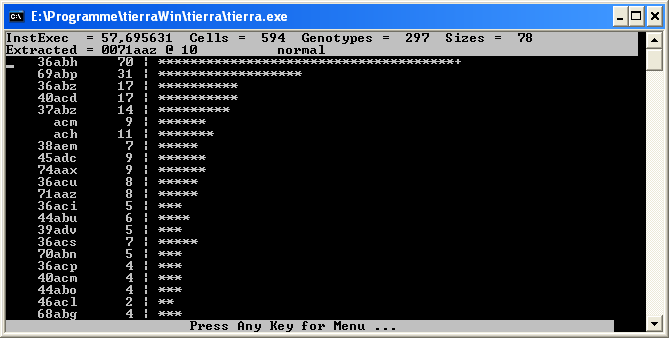 Tierra is a
Tierra is a computer simulation
Computer simulation is the process of mathematical modelling, performed on a computer, which is designed to predict the behaviour of, or the outcome of, a real-world or physical system. The reliability of some mathematical models can be dete ...
developed by ecologist Thomas S. Ray
Thomas S. Ray (also known as Tom Ray; born September 21, 1954) is an ecologist who created and developed the Tierra project, a computer simulation of artificial life.
In 1975, he and Donald R. Strong were the first to propose the theory of sko ...
in the early 1990s in which computer programs compete for time (central processing unit (CPU
A central processing unit (CPU), also called a central processor, main processor or just processor, is the electronic circuitry that executes instructions comprising a computer program. The CPU performs basic arithmetic, logic, controlling, and ...
) time) and space (access to main memory
Computer data storage is a technology consisting of computer components and recording media that are used to retain digital data. It is a core function and fundamental component of computers.
The central processing unit (CPU) of a computer ...
). In this context, the computer programs in Tierra are considered to be evolvable and can mutate, self-replicate and recombine. Tierra's virtual machine is written in C. It operates on a custom instruction set designed to facilitate code changes and reordering, including features such as jump to template (as opposed to the relative or absolute jumps common to most instruction sets).
Simulations
The basic Tierra model has been used to experimentally explore ''in silico
In biology and other experimental sciences, an ''in silico'' experiment is one performed on computer or via computer simulation. The phrase is pseudo-Latin for 'in silicon' (correct la, in silicio), referring to silicon in computer chips. It ...
'' the basic processes of evolutionary and ecological dynamics. Processes such as the dynamics of punctuated equilibrium, host-parasite co-evolution and density-dependent natural selection are amenable to investigation within the Tierra framework. A notable difference between Tierra and more conventional models of evolutionary computation
In computer science, evolutionary computation is a family of algorithms for global optimization inspired by biological evolution, and the subfield of artificial intelligence and soft computing studying these algorithms. In technical terms, they ...
, such as genetic algorithm
In computer science and operations research, a genetic algorithm (GA) is a metaheuristic inspired by the process of natural selection that belongs to the larger class of evolutionary algorithms (EA). Genetic algorithms are commonly used to gene ...
s, is that there is no explicit, or exogenous fitness function built into the model. Often in such models there is the notion of a function being "optimized"; in the case of Tierra, the fitness function is endogenous: there is simply survival and death.
According to Thomas S. Ray and others, this may allow for more "open-ended" evolution, in which the dynamics of the feedback between evolutionary and ecological processes can itself change over time (see evolvability), although this claim has not been realized – like other digital evolution systems, it eventually reaches a point where novelty ceases to be created, and the system at large begins either looping or ceases to 'evolve'. The issue of how true open-ended evolution can be implemented in an artificial system is still an open question in the field of artificial life.
Mark Bedau and Norman Packard developed a statistical method of classifying evolutionary systems and in 1997, Bedau ''et al.'' applied these statistics to Evita, an Artificial life model similar to Tierra and Avida, but with limited organism interaction and no parasitism, and concluded that Tierra-like systems do not exhibit the open-ended evolutionary signatures of naturally evolving systems.
Russell K. Standish
Russell K. Standish is a computational scientist based in Sydney, Australia. He was the founding director of UNSW'High Performance Computing Support Unitfrom 1997-2005. In 2005 he established a computational science consultancy calleHigh Performa ...
has measured the informational complexity of Tierran 'organisms', and has similarly not observed complexity growth in Tierran evolution.Standish, R.K. 2003 "Open-ended artificial evolution", ''International Journal of Computational Intelligence and Applications 3(2)'', 167-175
Tierra is an abstract model, but any quantitative model is still subject to the same validation and verification techniques applied to more traditional mathematical model
A mathematical model is a description of a system using mathematical concepts and language. The process of developing a mathematical model is termed mathematical modeling. Mathematical models are used in the natural sciences (such as physics, ...
s, and as such, has no special status. The creation of more detailed models in which more realistic dynamics of biological systems and organisms are incorporated is now an active research field (see systems biology
Systems biology is the computational modeling, computational and mathematical analysis and modeling of complex biological systems. It is a biology-based interdisciplinary field of study that focuses on complex interactions within biological syst ...
).
See also
* Avida * Digital organism * Digital organism simulator *Evolutionary computation
In computer science, evolutionary computation is a family of algorithms for global optimization inspired by biological evolution, and the subfield of artificial intelligence and soft computing studying these algorithms. In technical terms, they ...
* Fitness landscape
References
Further reading
* Bentley, Peter, J. 2001, "Digital Biology:How Nature is transforming Our Technology and Our Lives", Simon & Schuster, New York, NY. Previously published in Great Britain in 2001 by Headline Book Publishing. * Ray, T. S. 1991, "Evolution and optimization of digital organisms", in Billingsley K.R. et al. (eds), ''Scientific Excellence in Supercomputing: The IBM 1990 Contest Prize Papers'', Athens, GA, 30602: The Baldwin Press, The University of Georgia. Publication date: December 1991, pp. 489–531. * Casti, John L. (1997). ''Would-Be-Worlds''. John Wiley & Sons, Inc. New YorkExternal links
Tierra home page
{{DEFAULTSORT:Tierra (Computer Simulation) Artificial life Artificial life models Digital organisms